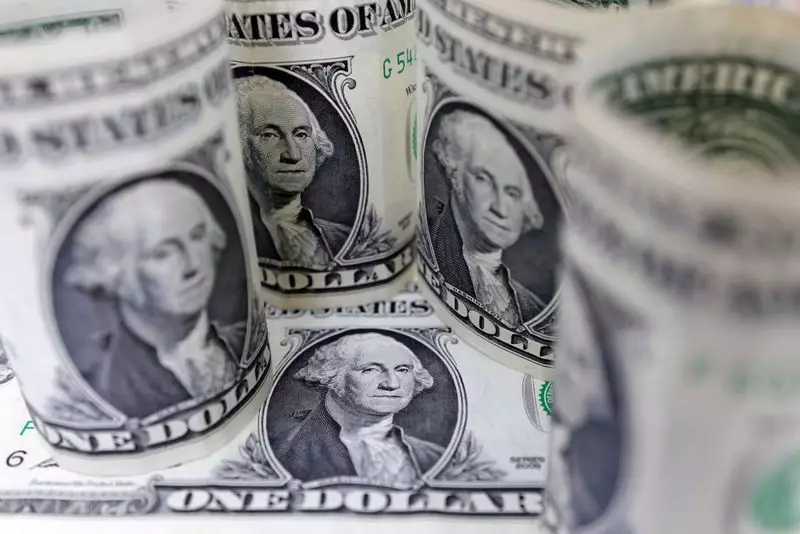As the U.S. presidential election approached, the financial markets exhibited a palpable sense of tension and uncertainty. Traders found themselves navigating volatile waters, cautiously adjusting their positions ahead of an electoral outcome that could significantly influence their strategies. The prevailing sentiment shifted dramatically from a strong Republican backing, largely due to expectations surrounding Donald Trump’s economic policies, to a more balanced approach as polls began to favor Democratic candidate Kamala Harris.
Recent polling data introduced an element of unpredictability regarding the election’s outcome, causing traders to reevaluate their positions with the dollar taking a notable hit. The anticipation of a Trump presidency, characterized by protectionist policies and a focus on tariffs, previously led many market participants to believe that his policies would promote inflation and, by extension, a stronger dollar. However, as polls suggested a more competitive race, with Harris gaining ground, market confidence in a Trump victory appeared to wane.
This shift was evident in the dynamics of betting platforms as well. PredictIt indicated a slight advantage for Harris, but alternative platforms like Polymarket still positioned Trump as the favorite. This lack of consensus highlighted the growing uncertainty within the market. The dollar index, which gauges the currency’s performance against a basket of major peers, remained static around 103.91, illustrating traders’ reluctance to commit fully in either direction as the election day loomed.
The dollar’s value dropped significantly, marking a 0.76% decline against the euro, hitting a three-week low. This decline was particularly dramatic after an opinion poll suggested Harris had unexpectedly taken the lead in traditionally Republican territory, indicating potential shifts in voter sentiment. Analysts observed that a victory for Harris could prompt further declines in the dollar, suggesting a possible 1% to 2% dip in the currency’s value, depending on the election’s outcome.
Conversely, if Trump were to secure a win, market analysts anticipated that the dollar might rebound sharply. Traders were generally wary, noting that any delays in vote counting or disputes surrounding the results could exacerbate volatility in currency markets. The implications of a protracted election process remained a concern for investors, especially with Trump’s previous indications of contesting unfavorable results.
While the dollar faced downward pressure, the cryptocurrency market displayed resilience, with Bitcoin experiencing a boost of 1.6% to a value near $68,140. This recovery followed a brief downturn that saw the cryptocurrency dip to a one-week low. Analysts posited that Trump’s policies might favor cryptocurrencies more than Harris’s strategies, adding another layer to the financial market’s complexity.
As the market braced itself for the Fed’s forthcoming interest rate decisions, traders were also reminded that the Bank of England and other global banks were similarly expected to adopt more accommodating monetary policies. Specifically, the Federal Reserve was anticipated to cut rates by 25 basis points, a move that highlighted concerns over the labor market’s performance, which fell short of economic expectations.
The prospect of lower interest rates may provide some support for equities but could lead to further depreciation in the dollar, especially if Biden was to secure a decisive victory. In contrast, a red wave could bolster confidence in U.S. assets, shifting the landscape of currency trading yet again.
Analyzing the broader monetary policy spectrum, the Reserve Bank of Australia maintained its course, reflecting a commitment to curbing inflation while keeping rates steady. In a similar vein, the Scandinavian countries were expected to navigate their monetary policies cautiously, with the Norwegian central bank opting to hold steady amidst external pressures.
The global financial landscape thus remained in a precarious state, with uncertainties stemming from U.S. electoral outcomes reverberating through currency markets worldwide. As such, traders were grappling with not only the immediate impacts of the U.S. election but also the longer-term implications for global monetary policies and their associated currency values.
In summation, the U.S. presidential election served as a pivotal moment for forex markets, as the outcome could determine not only the future of the dollar but also set the tone for global economic policy. Predicated on the evolving electoral landscape, traders remain on the edge, anticipating that the repercussions of this election will resonate through financial markets for weeks and perhaps months to come. As the nation prepared to cast its votes, the world watched closely, aware that the stakes transcended borders, touching upon the global economic framework that intertwines us all.

